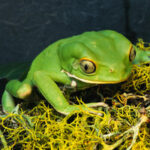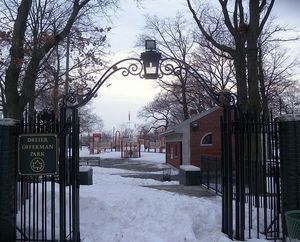Gray tree frogs are small (they usually measure about two inches in length) and occasionally colorful tree frogs native to North America. These frogs make excellent pets due to their hardiness, undemanding temperament, and the ease at which they adapt to new environments. Gray tree frogs can be purchased from many pet stores. Wild gray tree frogs should not be removed from their habitat, as this may stress them out.
Caring for a gray tree frog is fairly simple, making them great for those on a budget, or someone with little experience caring for amphibians.
Enclosure Size
The size of your gray tree frog enclosure should be large enough to allow the frog to move about and explore comfortably. Gray tree frogs are nocturnal, and during daylight hours will appear to sit motionless. Don’t be fooled; at night when they are active, gray tree frogs will need a lot of space. A general rule of thumb for enclosure size is about 3-gallons per frog. A good tree frog enclosure should be taller than it is wide, as gray tree frogs are arboreal in the wild.
Make sure the enclosure has a tightly fitted lid to prevent escapes.
Substrate and Accessories
Gray tree frogs thrive in moist, humid environments. A substrate that holds water is therefore best. When choosing a substrate remember that amphibians have delicate skin. Never use bark, sand or any chemically-treated substrate. Potting soil, river rocks, moist paper towels and coconut husk fiber work well and retain moisture.
Additionally your gray tree frog will need perches to climb on and hiding places to reduce stress. Make sure perches and climbing branches are sturdy and wide. A thin branch will make a gray tree frog feel unsafe, and it probably won’t be used. Covering a perch or branch partially with live or fake plants will provide a hiding space for your tree frog.
Water
Provide a large water dish in the tree frog enclosure. Gray tree frogs need to keep their skin moist, and will often soak in available water dishes. Make sure your water dish is large enough to allow for this, and always keep it full.
Food
Gray tree frogs are not picky eaters and can live almost entirely on crickets and mealworms purchased from a pet store. Periodically dust the tree frog’s food with a reptile calcium supplement to ensure a balanced diet. Food can be supplemented with wild-caught insects and spiders of most kind, as long as they are pesticide-free.
Light and Heat
In most cases gray tree frogs do not require special lighting or heat. These frogs are adapted to a temperate climate, and do well at room-temperature. Ideally day temperature should be kept from about 70 degrees to 75 degrees. Night temperature can fall lower, to about 65 degrees. Temperatures below 50 degrees will cause gray tree frogs to hibernate.
Special lighting is not necessary. If you do light the enclosure, make sure to avoid heat-generating light, as it can raise the cage temperature to high and dry out the frog and its environment.




